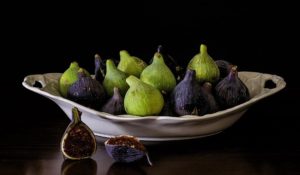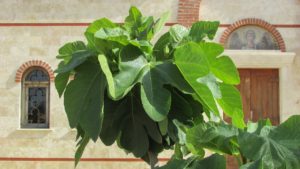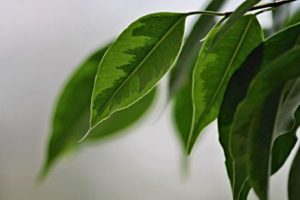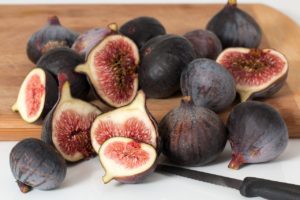2019
Updated 4/14/2024
Delectable, Edible Figs
The plant wish list grows longer each day. Within the next couple of years, I hope to move to a property with larger garden space, so I can shrink that list. First to be planted will be a couple of fig trees…blonde figs, purple figs…
Many years ago, our local Derwood, Maryland grocery store brought in fresh figs. I couldn’t believe it. So, I indulged in the extravagance, and bought a small box, at $9.00 or $10.00 per pound. The last time I had had fresh figs was about 25 years earlier, in Oradell, New Jersey… …
As a young girl, my first introduction to the delectable fig was when my maternal grandfather picked them from trees growing in his Englewood garden, two towns over. A substantial brick wall surrounded the back yard, as I recall, just beyond the monstrous cast iron stove in the kitchen.
My grandfather’s figs grew on the right side of the garden. On the left were my grandmother’s tomatoes, herbs, and where she threw out bread for the birds. I can still hear them—sparrows, tons of sparrows!
Papa’s Fig Trees
Salvatore and Catherina D’Arrigo married in Sicily, after, according to tradition, his sisters had been married and settled into their homes. Now, in 1906, they sailed across the Atlantic, to enjoy a new life of freedom and opportunity in the United States. After passing through Ellis Island, they settled near extended family members in Bergen County, New Jersey.
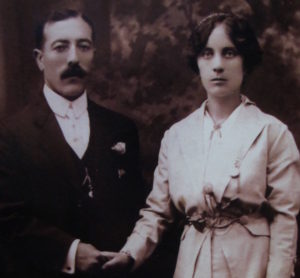
Nanny and Papa D’Arrigo, before setting sail for America.
Industrious and self-sufficient, Nanny and Papa wasted no time getting down to business. They opened a tavern/restaurant and purchased a house. I imagine that, like Johnny Appleseed, wherever my grandfather landed, a fig tree grew. That part of the eastern seaboard, though, is quite cold in the winter, and not considered “fig country”.
But my grandfather had some tricks that worked, apparently, for his fig trees. In addition to his skills in business, Papa was also a landscape gardener. Must be in the DNA!
Every autumn, after the trees went dormant, he surgically severed part of the root system near the base of the tree. He bent over the trunk of the fig tree until it was just above the ground. Then he covered the trunk and branches with piles of leaves and burlap…all tucked in for the winter. In early spring, each fig tree was raised, pruned, and staked. (Other family members recall the standing trees simply being cloaked in layers of burlap, so he might have tried different methods.)
Recently I read that this was a common practice in Boston, New York City, Philadelphia, and other cold cities where the fig tree could not survive without a little manipulation.
Second Helping
It was a full half century after my grandparents had arrived on these shores when I had my first… fresh… fig from their garden. Papa passed away when I was 10 or 11, and Nanny, 5 years after that. So, we didn’t have too many years to enjoy those figs, but they certainly made an impression.
A quarter century after the last of Papa’s figs, those fresh figs showed up at the grocery store in Maryland. And yes! They tasted exactly as I had remembered them!
Origins Of the Fig Tree
The common fig (Ficus carica) is native to Turkey. By 5,000 B.C., it had been distributed throughout the Middle East and the Mediterranean region by Greek and Roman traders. Fig trees readily adapted to hot, dry summers and mildly cool winters, and they also made their way to England and China. They grow from sea level up to over 5,000′ in elevation.

But its roots go back much further than that. At a Neolithic archaeological site called Gilgal I, in the Jordan Rift Valley, evidence shows that fig trees were cultivated 11,400 years ago.
Remains of a plant found in a home dating to that period indicate that early populations knew how to vegetatively propagate fig trees from cuttings. The parthenocarpic “mutant” they grew was a sterile form that bore fruit without pollination.
Cultivated for human consumption, figs are probably the oldest domesticated crop. Figs predate by a thousand years the earliest agricultural grains—wheat, barley, and rye.
Sumerian stone tablets from 2500 B.C. recorded culinary uses of the fruit. For thousands of years, before sugar gained widespread use, figs sweetened foods and desserts.
Legendary twins Romulus and Remus have been depicted under the bough of a fig tree as they were fed by the mother wolf. The forbidden fruit, of Bible fame, was probably the fig and not the apple. Figs have long figured in religious symbolism, associated with peace, prosperity, and fertility.
The term “fig” was first used in the English language in the 13th century. It is derived from the Old French figue, and the Romance fica (Ficus is the genus name for edible figs and for the hundreds of tropical species).
The Fig Moves To The New World
Early explorers brought fig trees to the New World as early as the 15th century. And the Spanish Franciscan missionaries are credited with planting figs in southern California from 1769. ‘Mission’ is a well-known variety, with excellent flavor and sweetness. It is parthenocarpic, not requiring pollination to set fruits.
Worldwide Production
Worldwide, Turkey produces the most figs, with 26% of the crop. Egypt, Algeria, Morocco, Iran, and the U.S. round out the rest of the top 6 producers. California, with a climate similar to the tree’s native land, grows almost the entire American commercial crop. Texas comes second.
Figs as Houseplants
This article describes the edible fig, which grows outdoors. The weeping fig (Ficus benjamina), the creeping fig (Ficus pumila), the rubber plant (Ficus elastica), and the ever-popular fiddle-leaf fig (Ficus lyrata) are primarily tropical houseplants, but they don’t produce edible figs for humans.
The edible fig tree does not grow well or produce fruit indoors.
Inside the Box
My father’s career centered around food photography, mostly with the Nabisco cookie company. We kids were delighted when he brought home samples of Fig Newtons, first becoming available in 1891. In fact, as a teenager, I spent one summer at the Fair Lawn NJ Nabisco plant deftly packing boxes of chocolate chip cookies and Fig Newtons.
This explains not only my fondness for these cookies, but also my complete aversion to anything sticky. Dirt’s okay; sticky is not.
If It’s Too Cold
Okay, I was determined to grow a fig tree. Most experts at the time said they wouldn’t survive Maryland’s cold winters. Much later, with a little research, I learned that there are several hardier varieties of fig trees. Most fig trees grow in USDA plant hardiness zones 7 through 9, with a few growing in zone 6, and several tolerating warmer zones. ‘Chicago Hardy’ is hardy to zone 5. Before choosing a particular variety, check its hardiness zone from a few sources. There are over 200 varieties to choose from.
A garden center called Behnke’s Nursery was the go-to place for plant nerds like me. But it was some distance around the clogged Beltway circling Washington, D.C., in Beltsville, Maryland. They retailed more species of plants than I had ever seen. Certainly, they’d have figs!
I bought a variety called ‘Brown Turkey’, one of two types available. The next year, I transplanted it into a bigger pot. Smaller varieties of figs can grow in 20-gallon pots or larger. The plan was to grow it outside in the summer, let it drop its leaves in the fall, and then move it into the unheated garage for the winter. There, it wouldn’t suffer from the lowest winter temperatures. And, because the fig tree bears fruit even when growing in a large container, this small effort would have fruitful dividends.
This routine served us well for several years, until that killer winter. One year, the temperatures dropped to lows we had rarely seen, and the wind blew its icy breath through the gaps around the garage door. My fault—I didn’t raise the fig tree off the floor or move it inside. Consequently, it froze solid and died. When the garage door was replaced, I went for the more expensive well-insulated model.
A Nod To Behnke’s
Just a few weeks ago, I read in one of the trade magazines that, sadly, Behnke’s is about to close its doors. Another pillar collapses. Many in the gardening world, it seemed, knew this company.
In fact, recently at the Hendersonville Garden Jubilee, Larry Morton, the bonsai vendor at Bella Bonsai Nursery, told me that he had worked there for a few years in the ’60’s. Small world… Here’s to Albert and Rose Behnke, German immigrants, who opened this nursery almost 90 years ago.
Headings
Page 1: Delectable, Edible Figs, Papa’s Fig Trees, Origins Of the Fig Tree (The Fig Moves To The New World, Worldwide Production, Figs as Houseplants, Inside the Box), and If It’s Too Cold (A Nod To Behnke’s)
Page 2: How To Plant and Grow Fig Trees, Hardiness, Sun, Soil Preparation For Fig Trees, Time To Plant (Mulch), Watering Fig Trees, Fertilizing, Pruning Fig Trees, Foliage, Fruits Of Fig Trees, That Little Fig Wasp, Problems, Types of Fig Trees, and Varieties of Fig Trees
